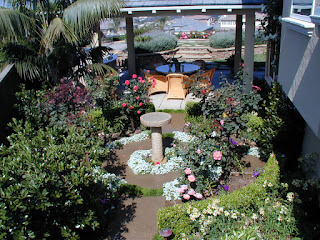ORGANIC AMENDMENTS
Believe it or not now is the time to incorporate organic amendments into your garden before the winter rains occur.
Organic amendments applied
during this time of year will take advantage of rain hopefully over winter
percolating nutrients into the root system of plant material which will promote
healthy grass growth in the spring.
Organic soil amendments improve
coarse-textured (sandy) soils by increasing the water and nutrient holding
capacity. Organic soil amendments help fight harmful plant diseases. Using
amendments from a local source can reduce fossil fuel use and air pollution
compared to shipping products across the country.
Here are a few benefits
of using Soil Amendments:
Spring Soil Preparation
Soil improvement is an ongoing
process and can sometimes take ten or more years to build productive garden
soil. If the soil has too much sand or too much clay, the solution to both is
the same add organic material.
Organic materials, also known
as organic amendments, break apart tight clays, provide aeration, and hold
water and nutrients in loose sands. Organic materials include compost, peat,
and manure.
How do I amend my soil?
Add a two-inch layer of organic
material over the surface of the planters. We suggest using four cubic yards of
organic material per 1,000 square feet. Mix the organic material thoroughly
with a tiller or spade to a depth of four to six inches.
What materials should I
use?
The best organic amendments are
coarse materials. Fibrous sphagnum peats work well, although more expensive
than compost or manure. We do not recommend using dusty, fine peats, since they
have a tendency to clog soil drainage. Good quality organic compost will not
only add nutrition to plants, but it will also rebuild poor soils through the
addition of microbial and fungal activity (inoculation).
When to add Amendments:
Different
varieties of plants require their unique amendments during the changing
seasons. Rich organic compost can be added anytime per year. We suggest
adding organic compost to the soil during late winter in preparation for
spring. Adding compost to the soil is
a fairly quick process and amendments
can take several weeks for
nutrients to percolate into the soil. Topping the planter with a layer of mulch
after the addition of amendments will help conserve water and promote microbial
activity between mulch and compost.
Did you give this a try? – Let
us know how it went.
When should I fertilize
my garden:
The best time to fertilize
landscape plants is when they begin to grow actively. Worst time to fertilize
plants is at the end of their growing season. Most trees, for example, begin to
awaken and grow in early spring, and typically are fertilized once in February
or March. The majority of shrubs produce active growth in the spring and early
summer, so we tend to fertilize them once around March or April. Lawns are
allowed to green up before fertilizing in late March or early April and are
fertilized again in mid-summer.
What is the most
valuable soil amendment to add to garden soil?
The most
valuable garden soil amendment is compost, which provides a
wide range of essential plant nutrients to soil structure and contains
bacteria, fungi, worms, and insects that support healthy plant growth.
What are some
water-conservative alterations I could perform to existing irrigation?
Replacing spay nozzels with MP
Rotator nozzles. MP rotator nozzels feature unique, multi-trajectory
rotating streams that deliver water at a steady rate. This slower application
rate allows water to gently soak in at rates that soils can absorb. Use the MP
Rotator to replace the sprinkler head on any conventional spray head body or
pop up the sprinkler for water savings of up to 30%.
You can
visit our Pages also Facebook Youtube Twitter Instagram Pinterest Tumblr WordPress Strikingly Flickr WordPress Wix Gmaps Houzz Blogger



Comments
Post a Comment